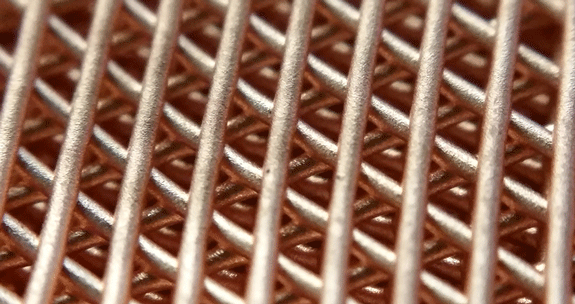Northwestern team develop innovative method for metal Additive Manufacturing
February 12, 2016
A team of engineers at Northwestern University, Illinois, USA, have reportedly created a new way to print three-dimensional metallic objects using rust and metal powders. The new rapid method is said to expand the type of metals, alloys, and architectures that can be additively manufactured.
While current methods rely on vast metal powder beds and expensive lasers or electron beams, Northwestern’s new technique uses liquid inks and common furnaces, resulting in a cheaper, faster, and more uniform process. The Northwestern team also demonstrated that the new method works for an extensive variety of metals, metal mixtures, alloys, and metal oxides and compounds.
“This is exciting because most advanced manufacturing methods being used for metallic printing are limited as far as which metals and alloys can be printed and what types of architecture can be created,” stated Ramille Shah, Assistant Professor of Materials Science and Engineering in the McCormick School of Engineering and of surgery in the Feinberg School of Medicine, who led the study. “Our method greatly expands the architectures and metals we’re able to print, which really opens the door for a lot of different applications.”
The new process involves a liquid ink made of metal or mixed metal powders, solvents and an elastomer binder which then allows rapid printing densely packed powder structures using a simple syringe-extrusion process, in which ink dispenses through a nozzle, at room temperature.
Despite starting with a liquid ink, the extruded material instantaneously solidifies and fuses with previously extruded material, enabling very large objects to be quickly created and immediately handled. The part is then sintered, allowing the powders to fuse together without melting.
“By uncoupling the printing and the sintering, it appears that we have complicated the process,” stated David Dunand, the James N. and Margie M. Krebs Professor of Materials Science and Engineering. “But, in fact, it has liberated us as each step is much easier separately than the combined approach.”
The research is described in a paper published in the journal Advanced Functional Materials. Adam Jakus, a postdoctoral fellow in Shah’s laboratory who was supported by a Department of Defense fellowship, and Shannon L. Taylor, a graduate student co-advised by Shah and Dunand who is supported by a National Science Foundation graduate fellowship, served as co-first authors. Undergraduate Nicholas R. Geisendorfer also co-authored the paper.
The team imagines that many disciplines could benefit from customised, quickly printed metals. The new method could be used for printing batteries, solid-oxide fuel cells, medical implants, and mechanical parts for larger structures, such as rockets and airplanes.
The researchers’ 3-D inks and process open doors for more sophisticated and uniform architectures that are faster to create and easier to scale up. After the object is printed, but before it is sintered, it is flexible due to the elastic polymer binder containing unbonded metallic powders. “We used a biomedical polymer that is commonly used in clinical products, such as sutures,” Shah explained. “When we use it as a binder, it makes green bodies that are very robust despite the fact that they still comprise a majority of powder with very little binder. They’re foldable, bendable, and can be hundreds of layers thick without crumbling. Other binders don’t give those properties to resulting 3D printed objects. Ours can be manipulated before being fired. It allows us to create a lot of different architectures that haven’t really been seen in metal 3-D printing.”
Shah and Dunand’s method can use many extrusion nozzles at one time. Their method could potentially print full sheets that are meters wide and can be folded into large structures. The only limitation is the size of the furnace.
Another innovative component of their process is that it can be used to print metal oxides, such as iron oxide (rust), which can then be reduced into metal. Rust powder is lighter, more stable, cheaper and safer to handle than pure iron powders. Shah and Dunand’s team discovered that they could first 3D print structures with rust and other metallic oxides and then use hydrogen to turn the green bodies into the respective metal before sintering in the furnace.
“It might seem like we are needlessly complicating things by adding a third reduction step where we turn rust into iron,” Dunand added. “But this opens up possibilities for using very cheap oxide powders rather than corresponding expensive metal powders. It’s hard to find something cheaper than rust.”

















